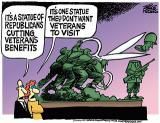Feb. 23, 2012 - The genuine and sincere gestures of support for our military and veterans are impressive.
Frequent, colorful displays highlight the season. Uniformed color guards and aircraft flyovers mark the start of games. Announcers ask all to stand to honor our men and women in the service and our national anthem. “Thank you for your service” is a common greeting from strangers. Yet, all is not well. The vast majority of those answering the nation’s call to serve stay in the service for a relatively short time. Upon leaving service, usually in their 20s, they return to communities that admire and appreciate their service, yet find it hard to communicate with them. The veterans’ potential value to academic and commercial institutions is not well-understood or appreciated.
As an example, a government official was recently reported as saying that being a qualified sniper does not translate well to civilian job qualifications. Well, no, not directly. But the goal orientation, dedication, mental discipline, judgment and maturity gained from success at such an arduous, exacting occupation surely should mean something to employers.
Our society did not always have this perception of veterans. Following World War II, America sent our returning veterans to college, university, and vocational training via the G.I. Bill. Through our veterans, the U.S. became the world’s leader, raised millions from poverty to middle class, vanquished polio, enabled the rebuilding of Japan and Germany, sent men to the moon, and defeated communism. The G.I. Bill achieved the all-time greatest return on investment of any government program.
Even today, we have excellent government programs to educate and train returning veterans. The most notable program is the Post-9/11 G.I. Bill. We have the Council on Veterans Employment. We have tax credits for employers to reward the hiring of disabled or unemployed veterans. The Department of Labor has job centers. We have public support from our highest officials. Yet, the challenge persists. The unemployment rates for veterans of our current wars exceeds the national average and that of veterans overall. read more>>>























No comments:
Post a Comment